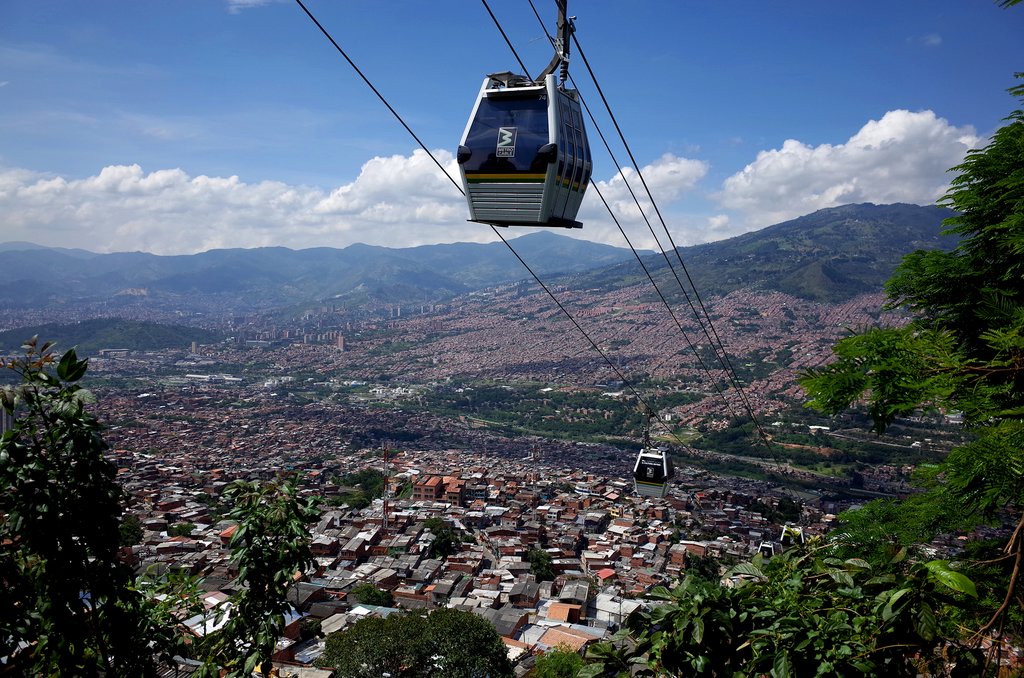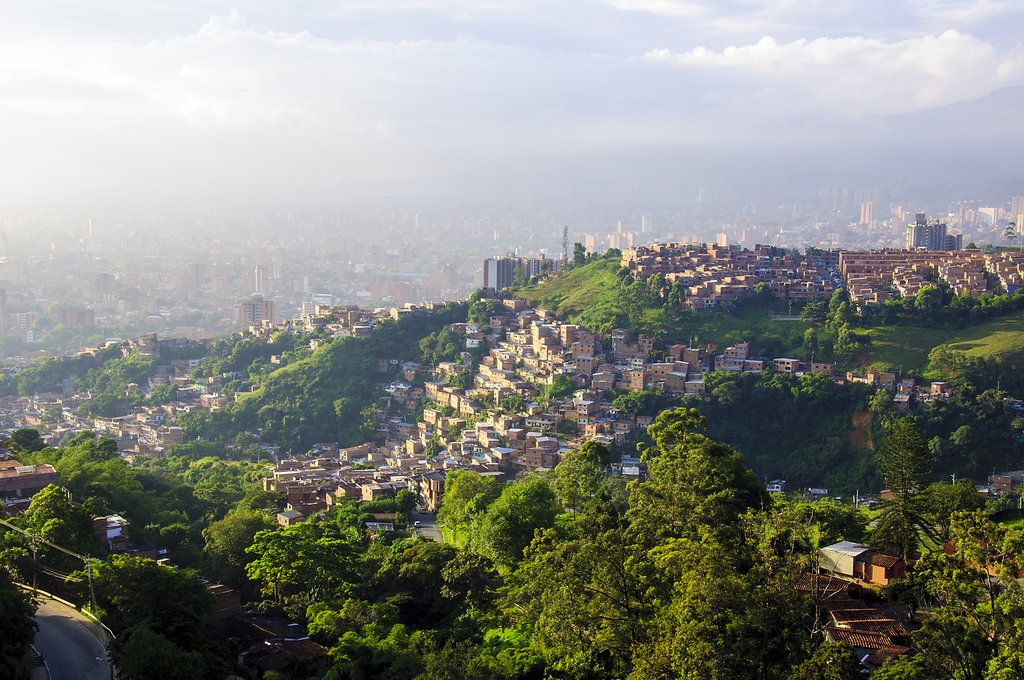Overview
With its stunning setting and eternally Spring-like climate, it’s easy to fall instantly in love with Medellín – a well-managed, self-assured, cosmopolitan city that has two distinct faces.
You’ll find few colonial-era edifices: The downtown is engagingly modern, with stunning contemporary architecture, hip nightclubs, and an encyclopedic list of museums and other venues of interest. In counterpoint, sprawling, impoverished barrios clamber up the surrounding hills. Paisas (locals) take civic pride in the city’s Uber-efficient mass transport system. Three MetroCable aerial tram lines and Metro rail network, completed in 1996 and connecting the barrios to downtown, have helped ease crime by integrating formerly disenfranchised communities with city life.
From a cable car ride into edgy Barrio Santo Domingo to a sensational night of salsa, there’s an astounding array of fantastic things to see and experience. Here are the best things not to be missed.
#1 Discover Botero sculptures downtown

A great way to start your visit is a walking tour of downtown Zona Centro, where the lion’s share of touristic sites concentrate in plazas studded with oversized, voluptuous sculptures by homegrown artist Fernando Botero in trademark dark chocolatey bronze.
Begin in Parque San Antonio. This austere plaza wins no beauty prizes, but it’s a must-see for the Pájaros de Paz – a bronze sculpture with twin “Birds of Peace.” One is shredded, the result of a bomb placed here in 1995, killing 22 people; the second, added in 2000, replicates the original.
Now walk north to lively Parque Berrío to admire the 18th-century Basilica Nuestra Señora de la Candelaria, the city’s most important church, now dwarfed by surrounding contemporary buildings. To the northwest side, a torso by Botero called La Gorda—The Fat Lady—stands in front of the Banco de la República.
Art-filled public parks lie at the heart of the city’s holistic makeover, and ground-zero is Plaza Botero, one block north of Parque Berrío. It’s named for the 23 oversize bronze sculptures of animals and naked humans, including ‘Soldado Romano’ (Roman Soldier)—locals believe it brings good luck in love to touch its genitals, which shine from being fondled. Now head inside the plaza’s Museo de Antioquia, a tri-level triptych displaying exhibits dedicated to Botero, other local artists, and Colombia’s diverse cultures.
#2 Ride the Metro to Barrio Santo Domingo

Medellín boasts an efficient mass transportation network and no visit would be complete without riding the well-policed MetroCable, a modern aerial-tram system which at peak hours runs every three minutes with Swiss-clock precision.
Every station has a puesto de policia (police bureau), but alighting to explore such barrios as the notorious Comuna 13 isn’t wise. The cable cars’ huge windows provide an excellent means of safely viewing the hard-edged slums from above.
The best ride whisks you sharply uphill from Acevedo station to Barrio Santo Domingo, a now peaceful mountainside slum where police once feared to tread. Here be sure to visit the black cubist Biblioteca España, a library perched dramatically over the tin-roofed cinderblock shanties.
If you have time, transfer in Santo Domingo to the adjacent Line L metro station and ascend beyond the city limits to Parque Arvi to hike the trails of this pristine forest reserve.
Chat with a local specialist who can help organize your trip.
#3 Get creative at Parque Explora

Head-scratching. Smile-inducing. Fascinating and fun. All sum up a visit to Parque Explora, an interactive science museum housed in a futuristic building adjacent to the Universidad de Antioquia, in Zona Norte.
Families flock to marvel at the more than 300 hands-on displays and experiences, plus a planetarium and 3D auditorium, intended to educate on biology, geography, media, physics, and technology.
A world-class aquarium (South America’s largest) on the upper level displays a wide variety of species found in Colombia’s rivers, from electric eels and piranhas to the pirarucu, an antediluvian species that grows to 3 m (10 ft). And a vivarium displays poison-dart frogs and snakes large and small.
#4 Enjoy the fun of the Feria de Los Flores

The area around Medellín is Colombia’s foremost center for flower production, so no surprise that the annual Festival of Flowers, is the City of Eternal Spring’s most important festival.
This ten-day, mid-summer celebration of regional Antioquian culture fills the streets with kaleidoscopic color and joy. The highlight is the Desfile de Silliteros, when porters (silliteros) carry extravagant floral arrangements into town on their backs.
Paisas (the term for locals) really know how to party, and there’s no end of other attractions to enjoy, from a special kids’ parade, a traditional cabalgata (horse parade), a motorcyclists’ parade, a classic automobile parade, plus fireworks and no end of musical concerts.
#5 Take a Pablo Escobar tour

One of the world’s most notorious criminals Pablo Escobar (1949-1993) is synonymous with Medellín. Once named the seventh richest man in the world, he rose from an impoverished childhood to control of the ruthless Medellín drug cartel.
To learn about his life and legacy, sign up for a half-day Pablo Escobar Historical Tour, which visits several sites associated with the infamous drug lord, who unleashed a brutal wave of violence throughout Colombia and famously offered police, judges, and politicians a choice of plata o plomo—silver (bribe) or lead (bullet).
Although responsible for countless assassinations and bombings, including that of Avianca flight 203, you’ll learn that Escobar was loved by many poor locals, who regarded him as a kind of Robin Hood for his philanthropic donations. However, there are many other locals who frown on the tours and do not support what they see as the exaltation of brutal terrorist.
If you do choose to take a tour, these typically begin with a visit to Edificio Monaco, Escobar’s five-story fortress-like cement home, scarred by two bombs planted by the rival Cali cartel. Then it’s on to his mountainside hideout where on December 2, 1993, Colombian special forces gunned down Escobar as he tried to flee across the roof. Finally, you’ll visit his grave at Cementerio Jardines de Montesacro, on the southern outskirts of the city. Don’t be surprised to see fresh flowers, placed by admirers.
#6 Thrill of a professional football game
Colombians are almost as crazy about football (soccer) as they are about beauty pageants. The fans’ passion is second to none, and watching one of Medellín’s two professional football teams--Atlético Nacional (considered the country’s top team) and Deportivo Independiente—play is an unforgettable experience.
Forget watching a game on TV. Head to the Estadio Atanasio Girardot (which the teams share) to watch a game live. The stadium is served by Estadio Metro station. The atmosphere of noisy revelry is intense. The most “passionate” fans congregate in the south side of the stadium. Sitting here can be overwhelming, especially if the fans’ excitement spills over into fist-fights or worse. Games between the two locals teams – whose rivalry is huge – are potentially the most volatile.
Games are usually held on Wednesdays, and sometimes on weekends.
#7 Have a late night on the town
A night on the town in MedellÍn means plenty of drinking and dancing. Boy, do Paisas love to dance! Reggaeton, salsa, bachata, vallenato. You name it! The place has a salsa caliente nightlife hot enough to cook the pork.
Great venues are sprinkled all over the city. The city’s nightlife is in constant flux, and an area that was hot one year may fall out of favor the next.
You can’t go wrong in El Poblabo, a bohemian enclave centered around Parque Lleras. At weekend nights the city’s young, stylish and beautiful throng the park, which is surrounded by several dozen great restaurants, bars, and nightclubs for every taste and budget.
A 20-minute walk south along Avenida Poblado takes you upmarket to Centro Comercial La Strada and Río Sur complex, each housing some of the most popular high-end clubs and rooftop bars.
The music is very loud at most dance venues: Forget talking, so down your drink, grab a partner, and hit the dance floor for a great time.
